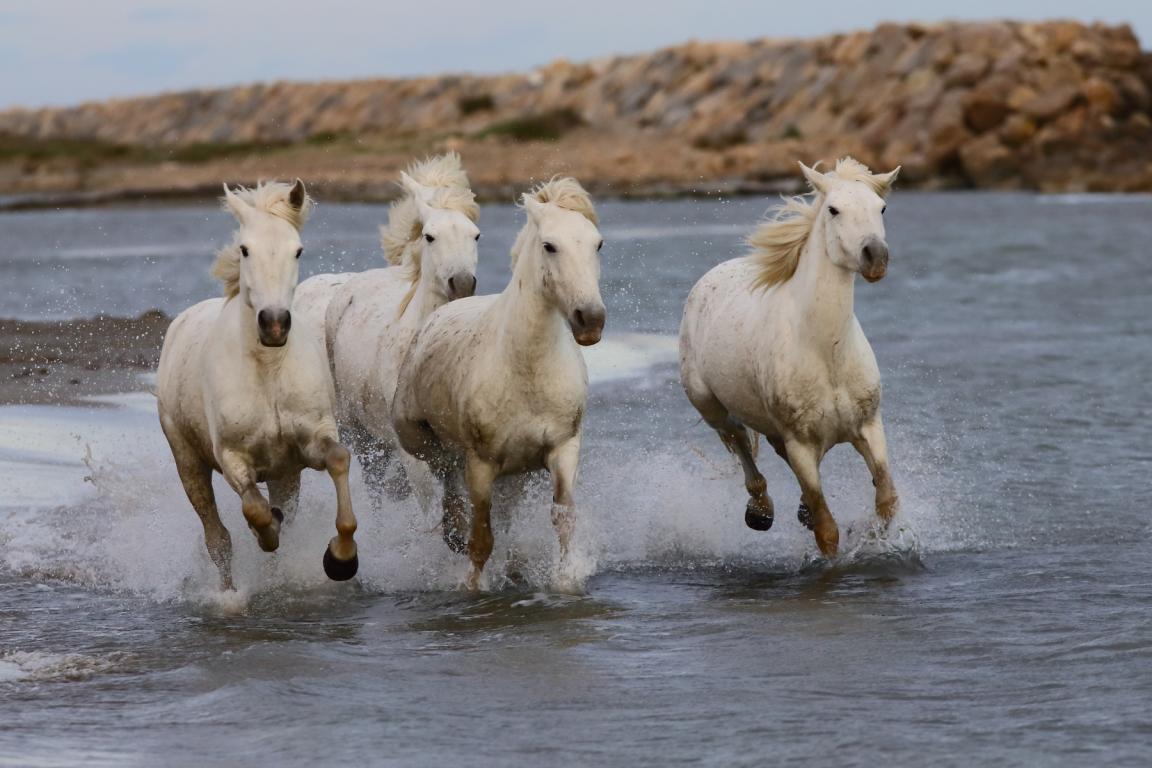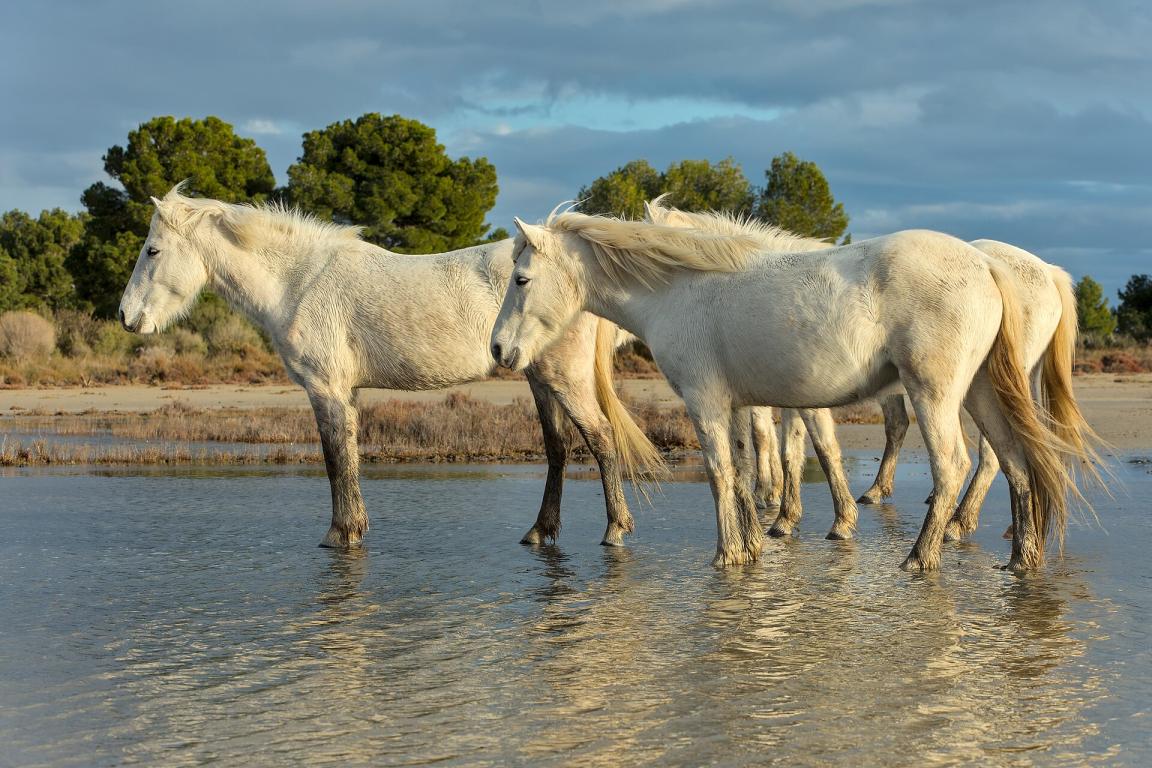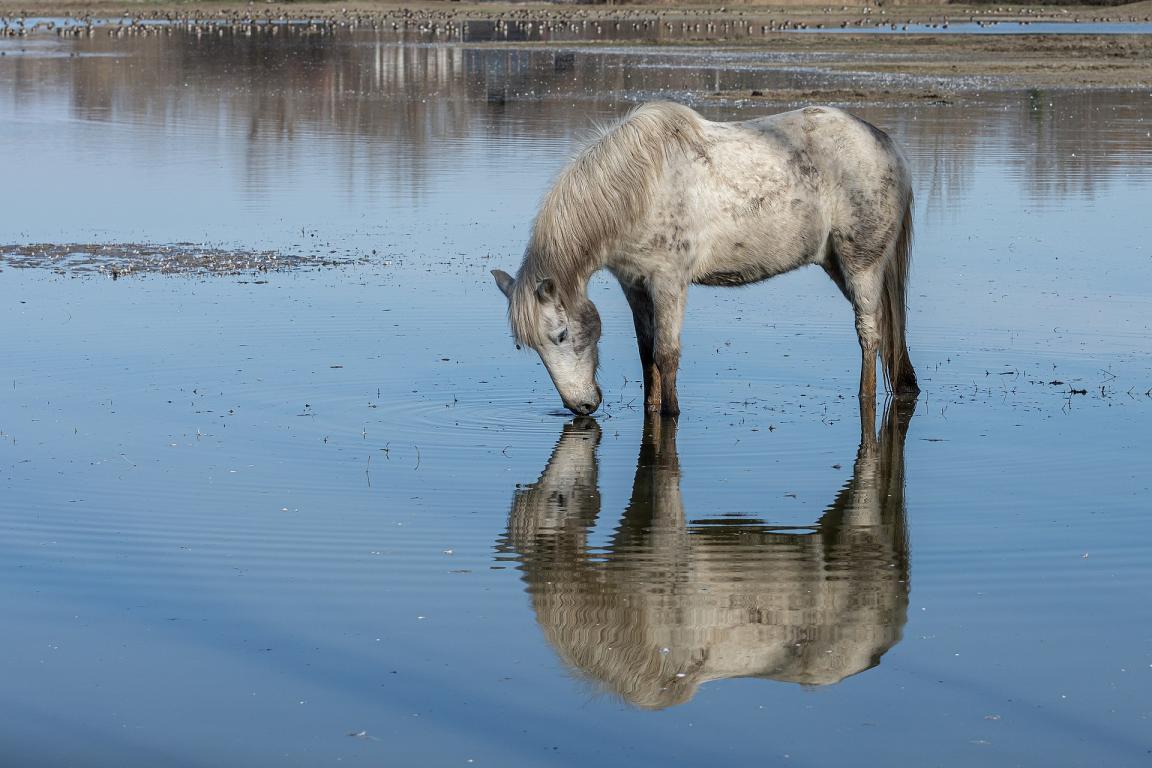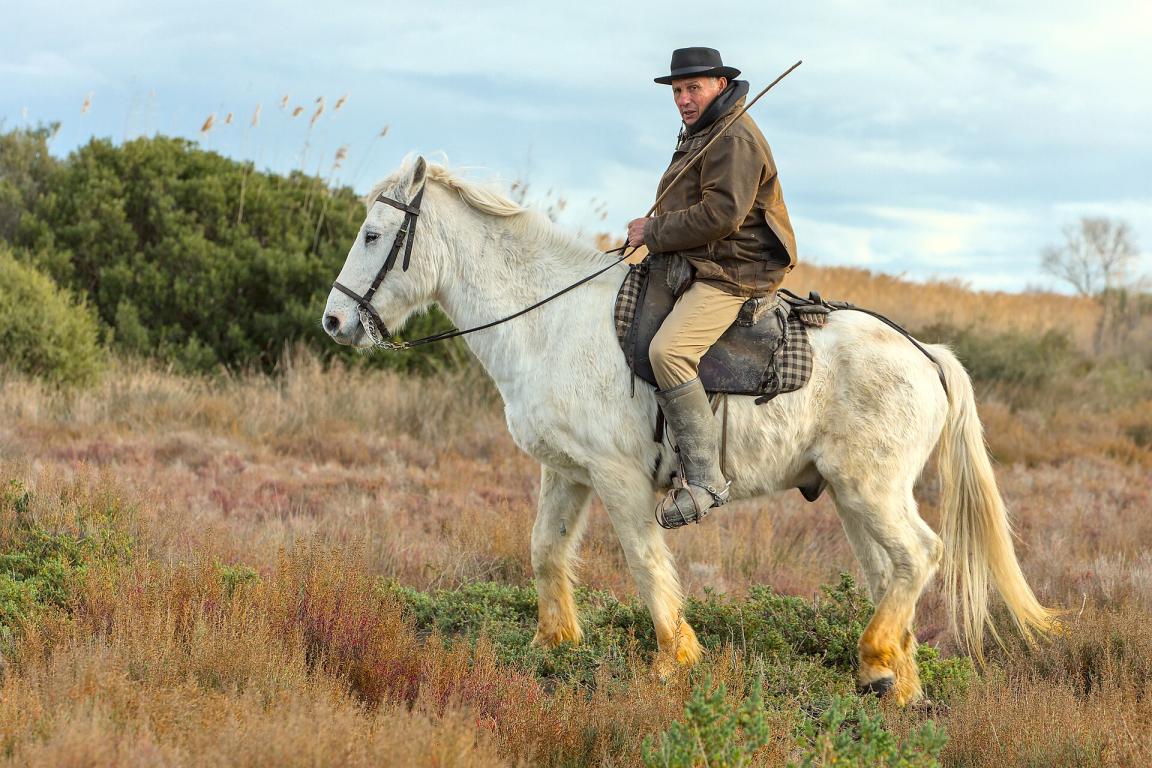
Continent: Europe
Country: France
Weight: 350 – 500 kg
Height: 135 – 150 cm



The Camargue Horse is an ancient and hardy breed, originating from the Rhône Delta in the south of France, at the heart of the Camargue region. For centuries, it has lived in semi-wild conditions in an environment made up of salt marshes, lagoons, and arid steppes.
Its origins are believed to date back to primitive equine populations that settled in the region as early as Antiquity. This horse was shaped by harsh natural selection, under difficult climatic conditions, which explains its robustness, resilience, and ability to thrive on poor forage.
The Camargue is closely tied to Provençal culture and the traditions of the gardians, the local cattle herders who raise fighting bulls. It has become a living symbol of the region’s heritage, especially within the manades (traditional free-range herds) and Camargue festivals.
It is one of the rare examples of a native horse breed still raised extensively within its original territory, following ancestral eco-pastoral practices.
The breeding of the Camargue Horse is historically and geographically tied to the Rhône Delta region, in the south of France.
It is primarily raised in the Camargue, a natural territory spanning three departments:
- Gard (30)
- Bouches-du-Rhône (13)
- and, to a lesser extent, Hérault (34)
The horses are raised in semi-wild conditions within manades, extensive traditional breeding farms located in wetlands, salt marshes, coastal steppes, and brackish grasslands (sansouïres).
The core breeding area is concentrated around the following towns:
- Les Saintes-Maries-de-la-Mer
- Aigues-Mortes
- Le Grau-du-Roi
- Arles
- Saint-Gilles
- and the Petite Camargue
Although traditionally confined to this region, satellite herds now exist in other parts of France, mainly for purposes of preservation, tourism development, or ecological land management (e.g. natural habitat maintenance).
The Camargue Horse holds significant genetic value as a preserved primitive breed, shaped by natural selection and adaptation to a demanding environment. Its unique genetic heritage makes it a reservoir of hardiness, disease resistance, and low nutritional requirements qualities highly sought after in conservation and crossbreeding programs.
Its ability to live outdoors year-round, survive in wetlands, and thrive on poor vegetation makes it a model of environmental resilience. It is sometimes considered a sentinel breed for fragile ecosystems.
From a genetic diversity standpoint, the Camargue is one of the limited-population breeds whose preservation is supported by official bodies (such as the IFCE, French National Studs, and the Camargue Regional Natural Park). Its closed stud-book, with strict registration criteria, helps maintain a pure lineage representative of the original type.
Though seldom used in modern sport horse breeding, it has important patrimonial and ecological value, especially in wetland management and sustainable pastoralism projects.
Ancient and Mysterious Origins :
The Camargue Horse is considered one of the oldest horse breeds in Europe. Its exact origins remain unclear, but it likely descends from primitive equine populations that inhabited the Rhône Delta as early as prehistoric times. Cave paintings discovered in the region show horses depicted during the Upper Paleolithic period. The breed may share ancestry with the Tarpan or other wild Eurasian horses.
Natural Selection in a Harsh Environment :
This horse developed over centuries through natural selection, in the marshy and saline zones of the Camargue. It had to adapt to a difficult environment: humidity, heat, insects, and poor-quality forage. These conditions shaped an animal that is extremely hardy, resilient, and frugal. Crossbreeding was rare, allowing it to retain strong primitive traits.
Cultural and Working Role with the Gardians :
Since the Middle Ages, the Camargue Horse has been inseparable from the life of the gardians—the traditional Camargue horsemen who raise fighting bulls in the manades. As a working mount, it is used to herd livestock, often through water, and in traditional bull-related games. It has become a living symbol of Camargue identity.
Official Recognition in the 20th Century :
Despite its ancient roots, the official stud-book for the Camargue Horse was only established in 1978 in France. Precise morphological criteria were defined to protect the original type. The breed was then formally recognized as part of the living heritage of the Camargue, with a distinctive brand in the shape of the Camargue cross (known as the fer de manade) applied to the left side of the neck.
Toward Broader Recognition :
Since the 2000s, the Camargue Horse has been gaining interest beyond its native region, especially for leisure riding, environmental programs, and equestrian shows. It is also being valued in ecological land management projects through natural grazing.
The Camargue Horse is known for its calm temperament, resilience, and natural intelligence. Accustomed for centuries to living freely in harsh conditions, it has developed a strong sense of autonomy, an excellent memory of terrain, and an innate balance, especially on unstable or marshy ground.
It is a docile horse, easy to train when handled with respect and patience. It maintains a close bond with humans, particularly with the gardians, making it an excellent partner for herding work and outdoor riding.
Highly sociable with other horses, it lives peacefully in herds. It has an honest and uncomplicated character, yet remains alert and lively, making it reliable even in unpredictable environments.
In summary, the Camargue Horse combines composure, bravery, mental toughness, and a deep connection with humans—qualities that make it an ideal companion for work, leisure, and nature.
"Hardy, brave, and close to man, the Camargue Horse embodies the wild freedom of the southern marshlands."
The Camargue Horse is enjoying growing recognition, both for its cultural heritage value and its natural abilities.
Its future appears promising thanks to several positive trends:
- Preservation of traditional breeding: The transmission of manadier know-how and the support of local institutions (such as the Camargue Regional Natural Park and the IFCE) help maintain breeding practices that respect the original type.
- Tourism development: The breed is increasingly present in leisure activities, especially wetland rides, trail riding, and shows related to Camargue culture, which enhance its visibility.
- Ecological use: The Camargue Horse is more and more involved in natural grazing programs for maintaining protected areas (marshes, lagoons, wet meadows), reinforcing its role in sustainable land management.
- Moderate international recognition: While less exported than other breeds, the Camargue is attracting growing interest abroad, particularly as a hardy, eco-friendly horse.
- Challenges to monitor: Inbreeding, declining number of manades, urban pressure on natural lands, and climate change could threaten the current balance. Controlled efforts in genetic diversification and promotion beyond the Camargue region are therefore necessary.
The Camargue Horse is known for its natural hardiness and disease resistance, the result of ancestral selection in a harsh environment. It tolerates outdoor living, climate variations, humidity, and unstable terrain remarkably well.
There are no known genetic predispositions to serious hereditary diseases. Its strong, healthy hooves require minimal care, and the breed is noted for its long lifespan.
However, like all horses living in humid areas, it may be susceptible to certain skin conditions (such as sweet itch or mud fever) if hygiene is neglected. In modern breeding, inbreeding should also be monitored due to the limited size of the stud-book population.

Excerpt from the program "Des Racines et Des Ailes: Au fil du Rhône" broadcast on 01/18/2017. Along the Petit Rhône, "there are more animals than human beings!" We follow a horse transhumance through this superb Camargue region where land and sea meet. A beautiful journey where the herd ends up joyfully frolicking in the waves of the Mediterranean!

Excerpt from the show: INTO THE FRENCH WILD, PROVENCE. The Camargue horse is able to graze underwater, a unique characteristic among horses. It is perfectly adapted to its natural environment. INTO THE FRENCH WILD is a show broadcast on the Nat Geo Wild channel. More information, photos, and videos at natgeotv.com.